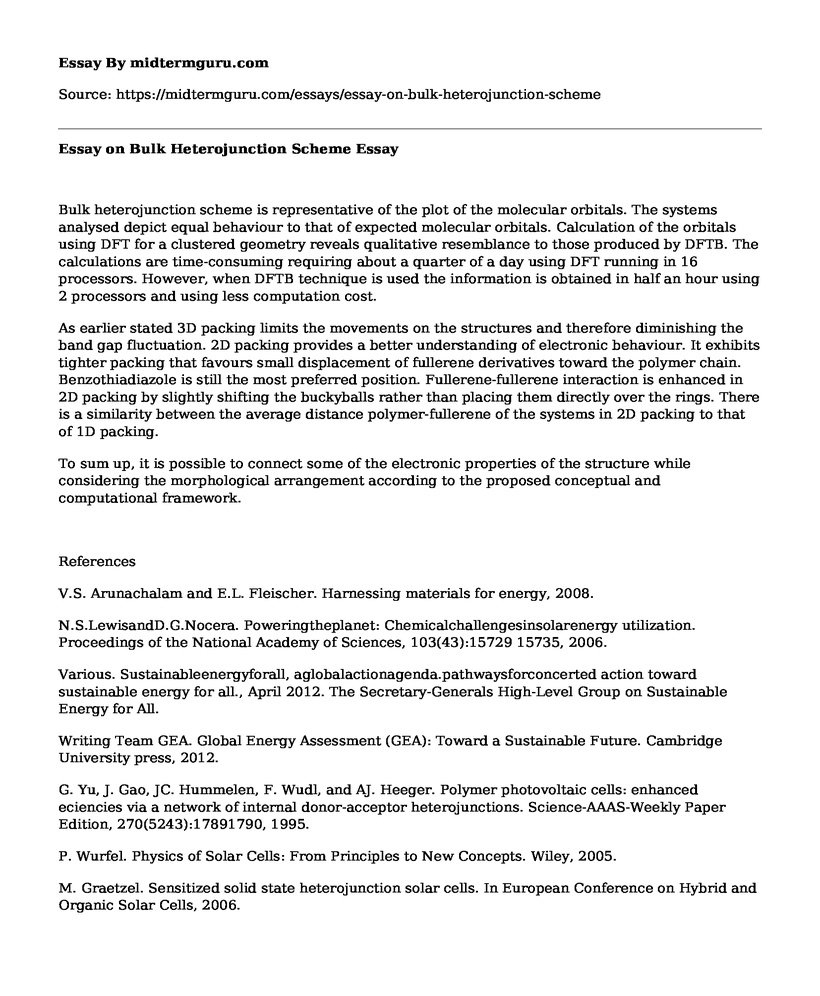Bulk heterojunction scheme is representative of the plot of the molecular orbitals. The systems analysed depict equal behaviour to that of expected molecular orbitals. Calculation of the orbitals using DFT for a clustered geometry reveals qualitative resemblance to those produced by DFTB. The calculations are time-consuming requiring about a quarter of a day using DFT running in 16 processors. However, when DFTB technique is used the information is obtained in half an hour using 2 processors and using less computation cost.
As earlier stated 3D packing limits the movements on the structures and therefore diminishing the band gap fluctuation. 2D packing provides a better understanding of electronic behaviour. It exhibits tighter packing that favours small displacement of fullerene derivatives toward the polymer chain. Benzothiadiazole is still the most preferred position. Fullerene-fullerene interaction is enhanced in 2D packing by slightly shifting the buckyballs rather than placing them directly over the rings. There is a similarity between the average distance polymer-fullerene of the systems in 2D packing to that of 1D packing.
To sum up, it is possible to connect some of the electronic properties of the structure while considering the morphological arrangement according to the proposed conceptual and computational framework.
References
V.S. Arunachalam and E.L. Fleischer. Harnessing materials for energy, 2008.
N.S.LewisandD.G.Nocera. Poweringtheplanet: Chemicalchallengesinsolarenergy utilization. Proceedings of the National Academy of Sciences, 103(43):15729 15735, 2006.
Various. Sustainableenergyforall, aglobalactionagenda.pathwaysforconcerted action toward sustainable energy for all., April 2012. The Secretary-Generals High-Level Group on Sustainable Energy for All.
Writing Team GEA. Global Energy Assessment (GEA): Toward a Sustainable Future. Cambridge University press, 2012.
G. Yu, J. Gao, JC. Hummelen, F. Wudl, and AJ. Heeger. Polymer photovoltaic cells: enhanced eciencies via a network of internal donor-acceptor heterojunctions. Science-AAAS-Weekly Paper Edition, 270(5243):17891790, 1995.
P. Wurfel. Physics of Solar Cells: From Principles to New Concepts. Wiley, 2005.
M. Graetzel. Sensitized solid state heterojunction solar cells. In European Conference on Hybrid and Organic Solar Cells, 2006.
B. VanCampen, D. Guidi, and G. Best. Energia solar fotovoltaica para la agricultura y desarrollo rural sostenibles. Online, 2000. FAO - Documento de Trabajo sobre Medio Ambiente y Recursos Naturales, No. 3.
N. Robertson. Optimizing dyes for dye-sensitized solar cells. Angewandte Chemie International Edition, 45(15):23382345, 2006.
Graetzel. Photoelectrochemical cells. Nature, 414:338444, 2001.
B. P. Rand, J. Genoe, P. Heremans, and J. Poortmans. Solar cells utilizing small molecular weight organic semiconductors. Progress in Photovoltaics: Research and Applications, 15(8):659676, 2007.
L. Dai, D. W. Chang, J-B. Baek, and W. Lu. Carbon nanomaterials: Carbon nanomaterials for advanced energy conversion and storage (small 8/2012). Small, 8(8):11221122, 2012.
P. Schuster, G. C. Maitland, M. Rigby, E. B. Smith, and W. A. Wakeham. Intermolecular forces - their origin and determination. Berichte der Bunsengesellschaft fur physikalische Chemie, 87(3):291292, 1983.
S. S. Patnaik and R. Pachter. A molecular simulations study of the miscibility in binary mixtures of polymers and low molecular weight molecules. Polymer, 43(2):415 424, 2002.
P. Mukerji. Polymer-polymer miscibility. Journal of Polymer Science: Polymer Letters Edition, 18(8):582582, 1980.
I. Yarovsky and E. Evans. Computer simulation of structure and properties of crosslinked polymers: application to epoxy resins. Polymer, 43(3):963 969, 2002. Mattice Special Issue.
P.K. Valavala, T.C. Clancy, G.M. Odegard, and T.S. Gates. Nonlinear multiscale modeling of polymer materials. International Journal of Solids and Structures, 44(3-4):11611179, 2007.
B.Aradi,B.Hourahine,andTh.Frauenheim. Dftb+,asparsematrix-basedimplementationofthedftbmethod.TheJournalofPhysicalChemistryA,111(26):5678 5684, 2007. PMID: 17567110.
C. K. Chiang, S. C. Gau, Jr. C. R. Fincher, Y. W. Park, A. G. MacDiarmid, and A. J. Heeger. Polyacetylene, (ch)[sub x]: n-type and p-type doping and compensation. Applied Physics Letters, 33(1):1820, 1978.
C.Piliego,D.Jarzab,G.Gigli,Z.Chen,A.Facchetti,andM.A.Loi. Highelectron mobility and ambient stability in solution-processed perylene-based organic eldeect transistors. Advanced Materials, 21(16):15731576, 2009.
C. W. Tang. Two-layer organic photovoltaic cell. Applied Physics Letters, 48(2):183185, 1986.
B.C.ThompsonandJ.M.J.Frechet. Polymer-fullerenecompositesolarcells. Angewandte Chemie International Edition, 47(1):5877, 2008.
H. Spanggaard and F. C. Krebs. A brief history of the development of organic and polymeric photovoltaics. Solar Energy Materials and Solar Cells, 83:125146, 2004.
W. Humphrey, A. Dalke, and K. Schulten. VMD Visual Molecular Dynamics. Journal of Molecular Graphics, 14:3338, 1996.
L. Liao, L. Dai, A. Smith, M. Durstock, J. Lu, J. Ding, and Y. Tao. Photovoltaicactive dithienosilole-containing polymers. Macromolecules, 40(26):94069412, 2007.
O. Y. Borbulevych, R. D. Clark, A. Romero, L. Tan, M. Y. Antipin, V. N. Nesterov, B. H. Cardelino, C. E. Moore, M. Sanghadasa, and T. V. Timofeeva. Experimental and theoretical study of the structure of n,n-dimethyl-4-nitroaniline derivatives as model compounds for non-linear optical organic materials. Journal of Molecular Structure, 604(1):73 86, 2002.
W. M. C. Foulkes and R. Haydock. Tight-binding models and density-functional theory. Phys. Rev. B, 39:1252012536, Jun 1989.
M.Elstner,P.Hobza,T.Frauenheim,S.Suhai,andE.Kaxiras. Hydrogenbonding and stacking interactions of nucleic acid base pairs: A density-functional-theory based treatment. The Journal of Chemical Physics, 114(12):51495155, 2001.
M. Elstner, D. Porezag, G. Jungnickel, J. Elsner, M. Haugk, Th. Frauenheim, S. Suhai, and G. Seifert. Self-consistent-charge density-functional tight-binding method for simulations of complex materials properties. Phys. Rev. B, 58:7260 7268, Sep 1998.
Y. Ohta, Y. Okamoto, A. J. Page, S. Irle, and K. Morokuma. Quantum chemical molecular dynamics simulation of single-walled carbon nanotube cap nucleation on an iron particle. ACS Nano, 3(11):34133420, 2009. PMID: 19827761.
Cite this page
Essay on Bulk Heterojunction Scheme. (2021, May 28). Retrieved from https://midtermguru.com/essays/essay-on-bulk-heterojunction-scheme
If you are the original author of this essay and no longer wish to have it published on the midtermguru.com website, please click below to request its removal:
- Membrane Ultrafiltration: Preliminary Treatment of Wastewater
- O-Xylene and ISOMAR Process - Paper Example
- Questions, Problems and Answers on Heating and Temperature - Paper Example
- Essay on Chemistry Ethical Issues
- Annotated Bibliography on Interbreeding Between Humans and Neanderthals
- Essay Sample on Similarities and Differences Between Rome and Greece
- Research Paper on ESD Phenomena







